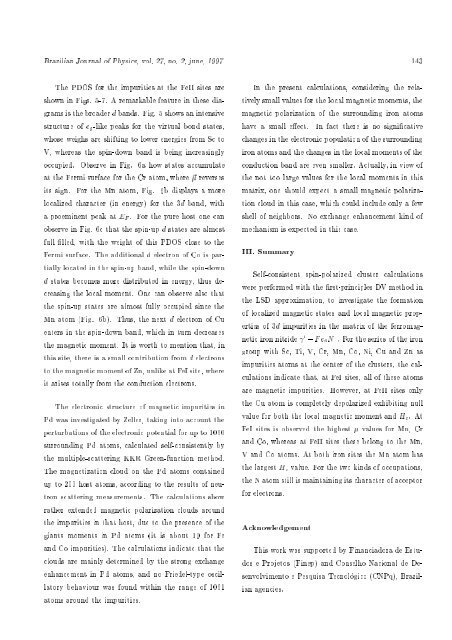Electronic Structure of Substitutional 3D Impurities in $\gamma
Electronic Structure of Substitutional 3D Impurities in $\gamma
Electronic Structure of Substitutional 3D Impurities in $\gamma
You also want an ePaper? Increase the reach of your titles
YUMPU automatically turns print PDFs into web optimized ePapers that Google loves.
Brazilian Journal <strong>of</strong> Physics, vol. 27, no. 2, june, 1997 143<br />
The PDOS for the impurities at the FeII sites are<br />
shown <strong>in</strong> Figs. 5-7. A remarkable feature <strong>in</strong> these diagrams<br />
is the broader d bands. Fig. 5 shows an <strong>in</strong>tensive<br />
structure <strong>of</strong> e g -like peaks for the virtual bond states,<br />
whose weighs are shift<strong>in</strong>g to lower energies from Sc to<br />
V, whereas the sp<strong>in</strong>-down band is be<strong>in</strong>g <strong>in</strong>creas<strong>in</strong>gly<br />
occupied. Observe <strong>in</strong>Fig. 6ahow states accumulate<br />
at the Fermi surface for the Cr atom, where ~ reverses<br />
its sign. For the Mn atom, Fig. 6b displays a more<br />
localized character (<strong>in</strong> energy) for the 3d band, with<br />
a proem<strong>in</strong>ent peakatE F . For the pure host one can<br />
observe <strong>in</strong> Fig. 6c that the sp<strong>in</strong>-up d states are almost<br />
full lled, with the weight <strong>of</strong> this PDOS close to the<br />
Fermi surface. The additional d electron <strong>of</strong> Co is partially<br />
located <strong>in</strong> the sp<strong>in</strong>-up band, while the sp<strong>in</strong>-down<br />
d states becomes more distributed <strong>in</strong> energy, thus decreas<strong>in</strong>g<br />
the local moment. One can observe also that<br />
the sp<strong>in</strong>-up states are almost fully occupied s<strong>in</strong>ce the<br />
Mn atom (Fig. 6b). Thus, the next d electron <strong>of</strong> Cu<br />
enters <strong>in</strong> the sp<strong>in</strong>-down band, which <strong>in</strong> turn decreases<br />
the magnetic moment. It is worth to mention that, <strong>in</strong><br />
this site, there is a small contribution from d electrons<br />
to the magnetic moment <strong>of</strong> Zn, unlikeatFeI site, where<br />
it arises totally from the conduction electrons.<br />
The electronic structure <strong>of</strong> magnetic impurities <strong>in</strong><br />
Pd was <strong>in</strong>vestigated by Zeller, tak<strong>in</strong>g <strong>in</strong>to account the<br />
perturbations <strong>of</strong> the electronic potential for up to 1060<br />
surround<strong>in</strong>g Pd atoms, calculated self-consistently by<br />
the multiple-scatter<strong>in</strong>g KKR Green-function method.<br />
The magnetization cloud on the Pd atoms conta<strong>in</strong>ed<br />
up to 200 host atoms, accord<strong>in</strong>g to the results <strong>of</strong> neutron<br />
scatter<strong>in</strong>g measurements. The calculations show<br />
rather extended magnetic polarization clouds around<br />
the impurities <strong>in</strong> that host, due to the presence <strong>of</strong> the<br />
giants moments <strong>in</strong> Pd atoms (it is about 10 for Fe<br />
and Co impurities). The calculations <strong>in</strong>dicate that the<br />
clouds are ma<strong>in</strong>ly determ<strong>in</strong>ed by the strong exchange<br />
enhancement <strong>in</strong>Pdatoms,andnoFriedel-type oscillatory<br />
behaviour was found with<strong>in</strong> the range <strong>of</strong> 1061<br />
atoms around the impurities.<br />
In the present calculations, consider<strong>in</strong>g the relatively<br />
small values for the local magnetic moments, the<br />
magnetic polarization <strong>of</strong> the surround<strong>in</strong>g iron atoms<br />
have a small eect. In fact there is no signicative<br />
changes <strong>in</strong> the electronic population <strong>of</strong> the surround<strong>in</strong>g<br />
iron atoms and the changes <strong>in</strong> the local moments <strong>of</strong> the<br />
conduction band are even smaller. Actually, <strong>in</strong> view <strong>of</strong><br />
the not too large values for the local moments <strong>in</strong> this<br />
matrix, one should expect a small magnetic polarization<br />
cloud <strong>in</strong> this case, which could <strong>in</strong>clude only a few<br />
shell <strong>of</strong> neighbors. No exchange enhancement k<strong>in</strong>d <strong>of</strong><br />
mechanism is expected <strong>in</strong> this case.<br />
III. Summary<br />
Self-consistent sp<strong>in</strong>-polarized cluster calculations<br />
were performed with the rst-pr<strong>in</strong>ciples DV method <strong>in</strong><br />
the LSD approximation, to <strong>in</strong>vestigate the formation<br />
<strong>of</strong> localized magnetic states and local magnetic properties<br />
<strong>of</strong> 3d impurities <strong>in</strong> the matrix <strong>of</strong> the ferromagnetic<br />
iron nitride 0 ; Fe 4 N .For the series <strong>of</strong> the iron<br />
group with Sc, Ti, V, Cr, Mn, Co, Ni, Cu and Zn as<br />
impurities atoms at the center <strong>of</strong> the clusters, the calculations<br />
<strong>in</strong>dicate that, at FeI sites, all <strong>of</strong> these atoms<br />
are magnetic impurities. However, at FeII sites only<br />
the Cu atom is completely depolarized exhibit<strong>in</strong>g null<br />
value for both the local magnetic moment andH c .At<br />
FeI sites is observed the highest values for Mn, Cr<br />
and Co, whereas at FeII sites these belong to the Mn,<br />
V and Co atoms. At both iron sites the Mn atom has<br />
the largest H c value. For the two k<strong>in</strong>ds <strong>of</strong> occupations,<br />
the N atom still is ma<strong>in</strong>ta<strong>in</strong><strong>in</strong>g its character <strong>of</strong> acceptor<br />
for electrons.<br />
Acknowledgement<br />
This work was supported by F<strong>in</strong>anciadora de Estudos<br />
e Projetos (F<strong>in</strong>ep) and Conselho Nacional de Desenvolvimento<br />
e Pesquisa Tecnologico (CNPq), Brazilian<br />
agencies.















